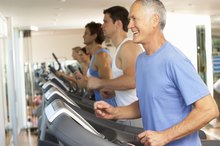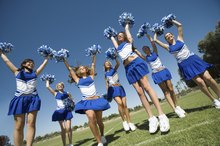How to Lose 5 Pounds in Two Weeks Through Exercise
Losing weight can feel daunting when you're competing with a hectic schedule or an already full life. You can lose 5 lbs. in two weeks by exercising regularly, but you will need to plan ahead and follow some simple exercise tips to improve your chances of success.
Using exercise to lose weight is a popular strategy because exercise burns calories and keeps your metabolism high. Work toward your goal by choosing activities that you enjoy and implementing exercise into your daily schedule.
Determine how many calories you will need to burn in two weeks. A pound is equal to 3,500 calories, so you must burn 17,500 calories to lose 5 lbs. in two weeks. That is 1,250 calories a day that you need to expend in some type of movement or exercise. How many calories you burn during exercise is a factor of how much you weigh, how much muscle mass you have and how hard or easy the exercise is. To determine how you will achieve the goal of 1,250 calories a day, use a calorie expenditure chart like the one at ExRx.
- Losing weight can feel daunting when you're competing with a hectic schedule or an already full life.
- That is 1,250 calories a day that you need to expend in some type of movement or exercise.
Goal Setting Ideas to Improve Cardiorespiratory Endurance
Learn More
Evaluate the two-week period you have chosen to lose the 5 lbs. You will need to work out every day to be successful. Be realistic and honest with yourself when you look at your current commitments, including both personal and work. Use an exercise time finder like the one at the My Exercise Plan website to fill in all the obligations you have. This will show you blocks of time that you can commit to your exercise. Put those on your calendar. Even small blocks of time each day will make a difference in your weight loss, but ideally one to two hours a day of exercise will help you reach your goal.
- Evaluate the two-week period you have chosen to lose the 5 lbs.
- Use an exercise time finder like the one at the My Exercise Plan website to fill in all the obligations you have.
Determine the intensity of your workout each day based on the amount of time you have. On days you have minimal time, increase the intensity of your workout so that at the end of the workout you feel as if you couldn't have done much more during that period. Conversely if you have large blocks of time, more than 45 minutes, your intensity can be lower. The Centers for Disease Control refers to exercise intensity as the level of effort required by a person to perform an activity. The Perceived Rate of Exertion Scale is typically a 1-to-10 scale, with 1 to 3 being very easy without any effort, 4 to 7 moderate intensity, including the ability to talk while performing the activity, and 8 to 10 as hard.
Exercise Plans for College Students
Learn More
Choose types of aerobic exercise that allow for maximum calorie burn. To achieve your two-week goal of 5 lbs., stick with high-intensity aerobic choices. Activities such as running or swimming that engage the entire body will be more intense and burn more calories. Group exercise classes like indoor cycling, kick-boxing or sports conditioning classes increase your heart rate and keep your metabolism raised after the class is over, allowing you to burn calories long after class has ended.
- Determine the intensity of your workout each day based on the amount of time you have.
- Group exercise classes like indoor cycling, kick-boxing or sports conditioning classes increase your heart rate and keep your metabolism raised after the class is over, allowing you to burn calories long after class has ended.
Consider two workouts a day when you can fit them in. You must burn 1,250 calories a day to reach your 5 lb. goal. Working out multiple times will keep your metabolism stoked for longer period of time. Your two-a-day workouts don't have to be hard or intense to count towards your weight-loss goal, but aim to stay above a 5 on the Perceived Exertion Scale. Simply going for a 30-minute walk over your lunch hour can burn 200 calories. Weight loss and exercise is all about burning more than you take in, creating a deficit. Taking advantage of even small windows of opportunities to burn additional calories will help you hit the 5 lb. mark in two weeks.
- Consider two workouts a day when you can fit them in.
- Simply going for a 30-minute walk over your lunch hour can burn 200 calories.
Tips
Do not combine this program with a low-calorie diet.
If you can't exercise enough to burn 1,250 calories, reduce your calories by the amount needed to create an equal deficit.
Focus on whole grain carbohydrates to fuel your body for the next workout. Get eight hours of sleep each night.
Warnings
This program should not be followed for an extended period of time. Consult a physician before starting this or any exercise program. Ideally, incorporate exercise into your lifestyle for a long-term commitment that will benefit you in numerous ways.
Related Articles
References
- Centers for Disease Control: Physical Activity for Everyone
- ExRx: Calorie Calculator
- Mul JD, Stanford KI, Hirshman MF, Goodyear LJ. Exercise and regulation of carbohydrate metabolism. Prog Mol Biol Transl Sci. 2015;135:17–37. doi:10.1016/bs.pmbts.2015.07.020
- Chiu CH, Ko MC, Wu LS, et al. Benefits of different intensity of aerobic exercise in modulating body composition among obese young adults: a pilot randomized controlled trial. Health Qual Life Outcomes. 2017;15(1):168. doi:10.1186/s12955-017-0743-4
- Calorie Control Council. Get moving calculator.
- US HHS. Activity guidelines questions and answers. Updated October 21, 2019.
- CDC. Measuring physical activity intensity. Updated January 29, 2020.
- Willis LH, Slentz CA, Bateman LA, et al. Effects of aerobic and/or resistance training on body mass and fat mass in overweight or obese adults. J Appl Physiol (1985). 2012;113(12):1831–1837. doi:10.1152/japplphysiol.01370.2011
- Carey DG. Quantifying Differences in the “Fat Burning” Zone and the Aerobic Zone: Implications For Training. Journal of Strength and Conditioning Research. 2011;25(8):1-1. doi:10.1519/jsc.0b013e3181f7c424
Writer Bio
Paula Stephens has a master's degree in exercise physiology and is certified by the American College of Sports Medicine. Currently she teaches at Metro State University in Denver and has a private Wellness practice. Her unique style of coaching helps clients make previously unattainable health breakthroughs.








